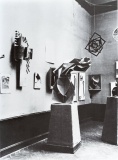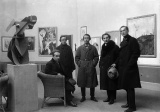First Russian Art Exhibition
The First Russian Art Exhibition [Erste russische Kunstausstellung] opened at the Van Diemen Gallery on Unter den Linden 21, near the Russian embassy in Berlin, on 15 October 1922. More than 700 works by 167 artists where shown, including paintings, graphic works, sculptures, as well as designs for theater, architectural models, and porcelain. The exhibition's official host was the Russian Ministry for Information, and it was put together by the artists Naum Gabo, David Shterenberg, and Nathan Altman. El Lissitzky designed the catalogue's cover. Gabo was in charge of the three rooms where Russian avant-garde art was presented, including several of his own sculptures. Due to the positive response in the press and the large number of visitors (ca. 15,000), the exhibition was prolonged until the end of the year. On the initiative of the International Workers' Assistance, the show was conceived as a commercial exhibition; the proceeds were to go to "Russia's starving". In the Spring of 1923, a version of the exhibition traveled to Stedelijk Museum, Amsterdam.
After the exhibition, the director of the Modern Department Friedrich A. Lutz, continued to show new art until 1926. The parent company and its subsidiaries were seized by the Nazis in 1935. [1]
Organisers of the exhibition photographed in one of the three avant-garde rooms on ground floor of Galerie van Diemen. L-R: David Shterenberg (head of IZO), D. Marianov (there on behalf of the Cheka), Nathan Altmann, Naum Gabo, Friedrich Lutz (gallery director). In the background are paintings by Shterenberg and an Archipenko sculpture; in the foreground Gabo's Torso of 1917. Photo: Willy Römer.
Catalogue[edit]
- Erste russische Kunstausstellung, Berlin, 1922, Galerie Van Diemen & Co., forew. D. Shterenberg, Redslob, and A. Holitscher, Berlin: Internationale Arbeiterhilfe, [1922], 31+[46] pp; repr., ed. Eberhard Roters, Cologne: Nachdruck König, 1988. (German)
Literature[edit]
- R. Šternberg, "Prva ruska umetnička izložba v Berlinu 1922", Zenit 17-18, Zagreb, Sep-Oct 1922, p 56. (Serbo-Croatian)
- [Branko] Ve Poljanski, "Kroz rusku izložbu u Berlinu", Zenit 22, Zagreb, Mar 1923, pp [4-5]. (Serbo-Croatian)
- "Through the Russian Exhibition in Berlin", trans. Maja Starčević, in From Between Two Worlds: A Sourcebook of Central European Avant-Gardes, 1910-1930, MIT Press, 2002. (English)
- Eckhard Neumann, "Russia's 'Leftist Art' in Berlin, 1922", Art Journal 27:1 (Autumn 1967), pp 20-23.
- The 1st Russian Show: A Commemoration of the Van Diemen Exhibition, ed. Andrei Nakov, London: Annely Juda Fine Art, 1983, 175 pp. (English)
- Roland Enke, "Malevich and Berlin", c2003.
See also[edit]
Links[edit]
| Art exhibitions and events | ||
|---|---|---|
|
Second Spring Exhibition of OBMOKhU (Moscow, 1920-21), Congress of International Progressive Artists (Düsseldorf, 1922), Congress of the Constructivists and Dadaists (Weimar, 1922), First Russian Art Exhibition (Berlin, 1922), New Art Exhibition (Vilnius, 1923), Zenit Exhibition (Belgrade, 1924), Contimporanul Exhibition (Bucharest, 1924), Machine-Age Exposition (New York, 1927), a.r. International Collection of Modern Art (Łódź, 1931), New Tendencies (Zagreb, 1961-73), The Responsive Eye (New York, 1965), 9 Evenings: Theatre and Engineering (New York, 1966), Cybernetic Serendipity (London, 1968), Live In Your Head: When Attitudes Become Form (Bern, 1969), Information (New York, 1970), Software - Information Technology: Its New Meaning for Art (New York, 1970), Documenta 5 (Kassel, 1972), Pictures (New York, 1977), Biennial of Dissent (Venice, 1977), Les Immatériaux (Paris, 1985), Magiciens de la Terre (Paris, 1989), Hybrid Workspace (Kassel, 1997) | ||


